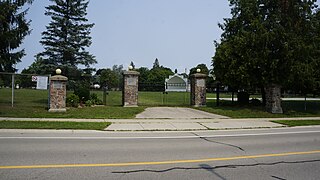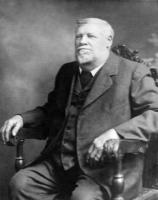
Kitchener is a city in the Canadian province of Ontario, about 100 km (62 mi) west of Toronto. It is one of three cities that make up the Regional Municipality of Waterloo and is the regional seat. Kitchener was known as Berlin until a 1916 referendum changed its name. The city covers an area of 136.86 km2, and had a population of 256,885 at the time of the 2021 Canadian census.

The Regional Municipality of Waterloo is a metropolitan area of Southern Ontario, Canada. It contains the cities of Cambridge, Kitchener and Waterloo, and the townships of North Dumfries, Wellesley, Wilmot and Woolwich. Kitchener, the largest city, is the seat of government.

Elmira is the largest community in the township of Woolwich, Ontario, Canada. It is 15 kilometres (9 mi) north of the city of Waterloo near the Regional Municipality of Waterloo's northern border with Wellington County. The community was listed in the 2016 Canadian census as having a population of 10,161.

The Township of Wilmot is a rural township in the Regional Municipality of Waterloo in southwestern Ontario, Canada.

The Township of Woolwich is a rural township in Southwestern Ontario. The municipality is located in the northeastern part of Waterloo Region and is made up of 10 small communities, with Elmira, Ontario the largest and St. Jacobs, Ontario the second largest. The population at the time of the 2021 Census was 26,999, up from the 2016 population of 25,006. Waterloo Region is still home to the largest population of Old Order Mennonites in Canada, particularly in the areas around St Jacobs and Elmira. They are often seen on the local roads using their traditional horse and buggy transportation; many also use horses to pull the implements in their farm fields.

Waterloo County was a county in Canada West in the United Province of Canada from 1853 until 1867, then in the Canadian province of Ontario from 1867 until 1973. It was the direct predecessor of the Regional Municipality of Waterloo.

West Montrose is an unincorporated rural community in Woolwich Township in the Regional Municipality of Waterloo, Ontario, Canada. As of the 2016 census, the population of the community was 257.
Galt is a community in Cambridge, Ontario, Canada, in the Regional Municipality of Waterloo, Ontario on the Grand River. Prior to 1973, it was an independent city, incorporated in 1915, but amalgamation with the village of Hespeler, the town of Preston and the village of Blair formed the new municipality of Cambridge. Being the largest constituent community in the city, it is commonly seen as the downtown core of Cambridge. The first mayor of Cambridge was Claudette Millar.

New Dundee is a small community of 1,119 people at the time of the 2016 Census, in the township of Wilmot, Ontario, Canada. It is located southwest of Kitchener.

Conestogo is a community in the Canadian province of Ontario, located in the township of Woolwich in Waterloo Region. The population in 2016 was 1,270.

Fanshawe Pioneer Village is an open-air museum established in 1959 and located in the Fanshawe Conservation Area in London, Ontario. The village uses historical re-enactments to communicate the history of rural communities in the former townships of Westminster, London, North Dorchester, Delaware, West Nissouri and Lobo in Middlesex County from 1820 to 1920 and the founding and development of the City of London up to 1840.

Jacob Gaukel Stroh was a local historian of Waterloo County, Ontario.

Phoebe Amelia Watson was a Canadian painter and curator. She worked in painted ceramics, watercolor and oils. She was the sister of Homer Watson, the well-known landscape artist, and devoted much of her life to promoting her brother's work, including her role as the curator of the Homer Watson Art Gallery at Doon.

Doon is a suburban community and former village which is now a part of the city of Kitchener, Ontario, Canada. Doon was settled around 1800 by German Mennonites from Pennsylvania, and after 1830 by Scottish immigrants. The area is located at the confluence of Schneider Creek and the Grand River. The post office was opened in 1845. A large flour mill, oatmeal mill, distillery and sawmill were built on the Doon River over the following years. The Perine brothers established extensive linen works and flax mills near the settlement. By 1870, there was a single church, Presbyterian, a variety of tradesmen and a population of 200.

The Waterloo Pioneer Memorial Tower was built in 1926 in Kitchener to commemorate the arrival of the Pennsylvania Dutch to Southwestern Ontario. It was conceived by William Henry Breithaupt, who wanted to heal wounds of nationalism fomented in the city during World War I. This led to increasing anti-German sentiment and an eventual change in the name of the city from Berlin to Kitchener.

Kitchener South—Hespeler is a provincial electoral district in Ontario, Canada. It was created in 2015 and has been represented in the Legislative Assembly of Ontario since the 42nd Ontario general election.

The Elman W. Campbell Museum is a museum in Newmarket, Ontario. Beginning with the first Quaker settlers in the early 1800s, the museum covers the history of Newmarket and the surrounding area, with a focus on local artifacts and their significance. It has several permanent exhibits, as well as space for temporary exhibits. Also available are community group programs for elementary school students and groups such as Scouts Canada.

Brubacher House is a historic house museum located in Waterloo, Ontario, Canada. It allows visitors to explore the everyday life of Pennsylvania German Mennonite settlers in Waterloo County from 1850 to 1890. The farmhouse is located on the traditional territory of the Attawandaron, Anishinaabeg, and Haudenosaunee Peoples.
Ken Seiling is a retired Canadian politician, most notable for serving as Regional Chair of the Regional Municipality of Waterloo from 1985 to 2018. He served as mayor of the lower-tier municipality of Woolwich in the 1970s. Notable policy legacies of Seiling include the controversial "countryside line", a municipally managed greenbelt and the development of Waterloo's light rail transit system, which was a defining topic in the 2014 election. He also helped spearhead action in the late 1990s and early 2000s to ban smoking indoors in Waterloo businesses. After 2014, Seiling was selected to co-lead a provincial report into efficiency and reform in municipal regional government.


















